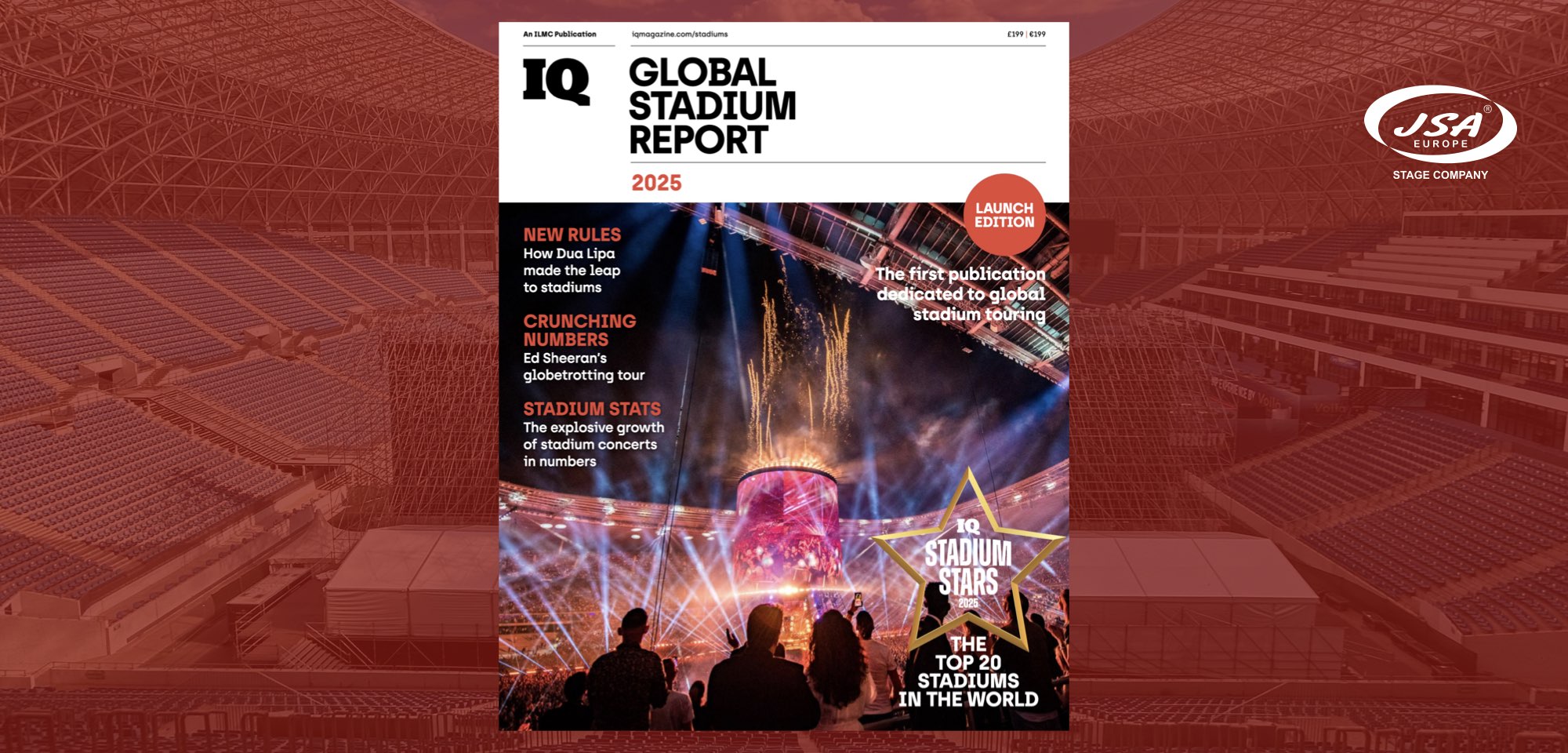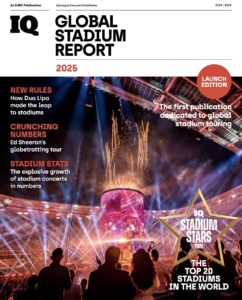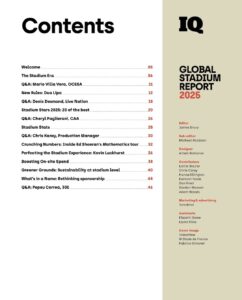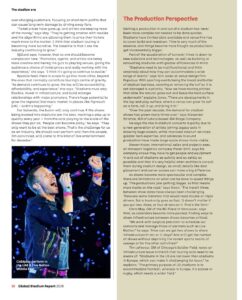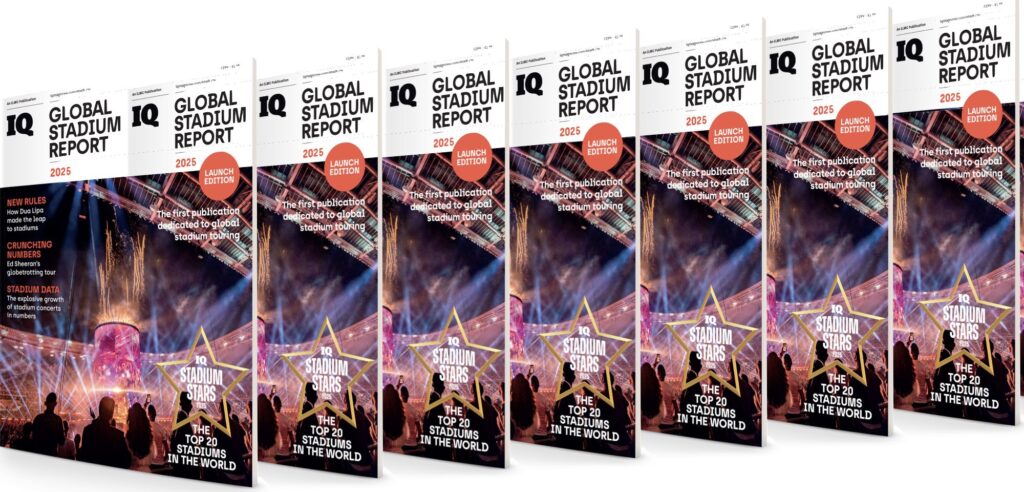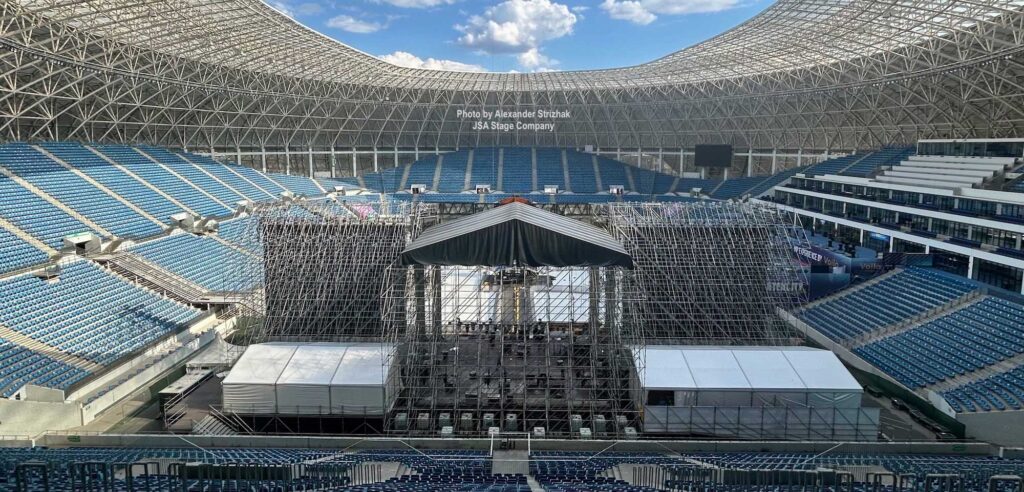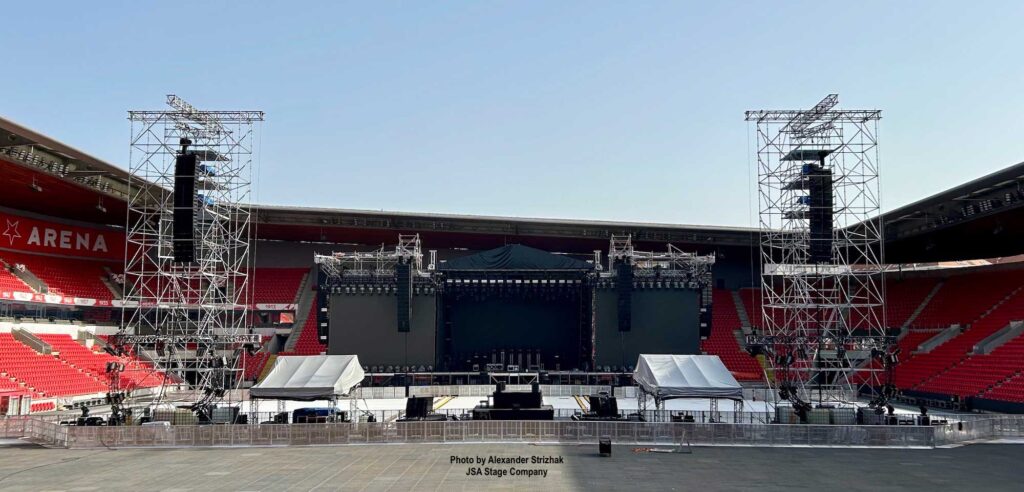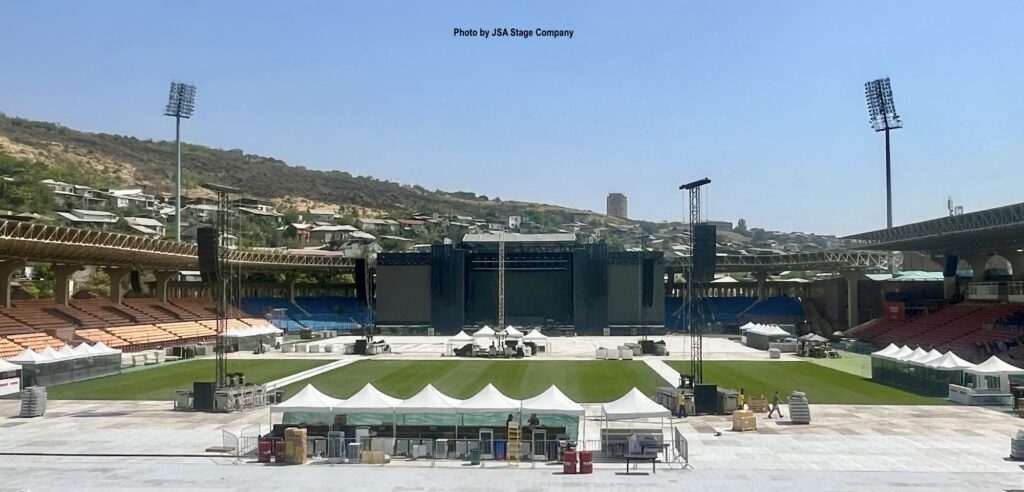We are pleased to announce the release of the first edition of the Global Stadium Report 2025. This is the most comprehensive publication ever published in the world dedicated to stadiums for live music concerts and other entertainment events.
The first report from the famous British professional IQ Magazine is dedicated to the rapidly developing global stadium business, describes the factors determining its development and contains exclusive information from leading stadium executives, promoters and event specialists. We are proud that JSA took part in this edition.
The Global Stadium Report is an essential resource for decision makers in the live music and stadium entertainment industries worldwide. JSA Founder and Managing Director Alexander Strizhak took part in the magazine’s survey on the topic. His opinion and comments on the development of stadium concerts were featured in the article “The Production Perspective” on page 10 of the issue. Read the full article below:
THE PRODUCTION PERSPECTIVE
Getting a production in and out of a stadium has never been more complex nor needed to be done quicker. Stadiums have limited slots available and venue hire has to cover build and teardown. Time is very much of the essence, and things become more fraught as productions get incrementally bigger.
Part of the acceleration of turnover times is down to new solutions and technologies, as well as building or renovating stadiums with greater efficiencies in mind.
“Stadiums need to be multifunctional and think creatively about how they can accommodate a wide range of events/’ says Tom Jones at venue design firm Populous. With sporting events being the bread and butter of stadium business, covering or removing the turf so it is not damaged is a priority. “Now we have moving pitches that slide the natural grass out and leave the hard surface underneath,” explains Jones. “There are developments in the lay-and-play surface, where a venue can grow its turf on a farm, roll it up, and bring it in.”
“Over the past decade, the demand for stadium shows has grown many times over,” says Alexander Strizhak, MD of Latvia-based JSA Stage Company.
He says the rise in stadium concerts is partly due to a new generation of artists joining legacy acts in drawing huge crowds, while improved stadium services, greater tech expertise, and advances in sound production have made large-scale shows more viable.
Steven Kroon, international sales and projects exec, at transport logistics company Pieter Smit, says his company knows they have to get people and equipment in and out of stadiums as quickly and as safely as possible and that it’s very helpful when architects consult them during stadium design, as small details like door placement and corner access can make a big difference.
As shows become more spectacular and complex, there are limitations on what can be done to speed things up. “The productions [are getting] bigger, so that means more trucks on the road,” says Kroon. “The transit times between show dates have always been challenging. There are some transfers that would need double or triple drivers. But a truck only goes so fast. It doesn’t matter if you put two, three, or four drivers on it. That’s the limit.”
Chris May, GM of the BC Place in Vancouver, says that, as calendars become more packed, finding ways to share infrastructure between shows becomes critical.
“We work with surgical precision to schedule our concerts and manage those of partners such as Live Nation,” he says. “How can we get two shows to share infrastructure in ten or 11 days? And still get the number of shows without depriving the tenant sports teams of usage or for the other activities?”
Tim LeFevour, GM of Chicago’s Soldier Field, notes an infrastructure issue in the US that touring acts need to be aware of: “Stadiums in the US are narrower than stadiums in Europe, which can make it challenging for tours,” he explains. “The primary purpose of US stadiums is to accommodate football, whereas in Europe, it’s soccer or rugby, which needs a wider field.”
View and read this special edition in PDF format here: GLOBAL STADIUM REPORT 2025
Attention!!! Viewing and reading the issue is only available by subscription. For those who are not subscribers to IQ-Mag magazine – a preliminary promo review can be viewed here: Global Stadium Report 2025 – Preview
Inside the Global Stadium Report:
Stadium Stars: In a groundbreaking first, IQ assembles the industry-voted list of 20 standout venues leading the way in innovation and success
New Rules: How Dua Lipa’s team prepared her to make the leap to stadium level
Crunching Numbers: The story behind Ed Sheeran’s mammoth stadium run
Stadium Stats: Analysis of key data on the stadium concert industry, in collaboration with Billboard Boxscore
The Stadium Era: A global look at how promoters and stadiums are adapting to the booming demand for concerts
Boosting On-Site Spend: The latest thinking on maximising customer spend on site
Greener Grounds: Checking in on sustainability at the stadium level
What’s In A Name: A deep dive into naming rights for stadiums: from rights holders’ and venues’ perspectives
Q&As with stadium leaders … and much more!
If necessary, you can purchase a print copy Global Stadium Report
Also read below the full “online interview” with Alexander Strizhak, conducted by IQ magazine during a survey of world experts and opinion leaders in the professional community on the topic of the growth of stadium concerts in recent years.
Questions from James Drury – Special Projects Editor:
– How have you seen demand for stadium shows change over the past decade? (if you can share numbers, eg “demand is up 150% since 2015”, that would be great)
– How does JSA help artists and venues adapt to the increasingly busy calendars/touring schedules (eg, can you share examples of things you’re doing to help make things more efficient/ load in-out etc)
– If you could give one bit of advice to stadium designers/architects about designing stadiums for concerts, what would it be?
Answers comment by Alexander Strizhak – Managing Director of JSA:
“As I see it from the news about concerts of world stars, observing the activities of partners from the technical sector of live music concerts and event production, as well as based on the experience of my company JSA – I clearly see that over the past decade, the demand for stadium shows has grown many times over. Note that some stars after the bad period of covid already in 2022 began to do several concerts at one stadium in one city. At first, it seemed that this was just a cumulative effect after a long break, but this continued later. It turned out that in one city a popular performer can collect two, three or even more audiences in a row at one venue. A cool example is a series of concerts of the singer Adele in Germany last year (a ten-show concert residency in Munich). Conventionally speaking, a special temporary “stadium” was built for this event. By the way, I think that this was done due to the fact that not a single serious stadium could afford to close a football field for such a long period as her concerts lasted.
Also, in recent times, many promoters have started to hold large festivals in stadiums more often. This has proven to be very effective, the event takes place in a city with accessible infrastructure. The stadium’s design allows for good control over ticket sales, the audience has a better view of the stage and receives normal service and security. In addition, the adjacent territory to the stadium sometimes allows for many other festival activities to be held around the arena. A good example of such a festival is UNTOLD (Cluj) and IntenCity (Craiova) in Romania, where JSA was involved in the installation of stage structures. This year, the popular NEVERSEA festival will take place at the National Arena in Bucharest, which in previous years was held in Constanta on the Black Sea coast. Of course, this is a different type and style of festival than those that traditionally take place outside the city (country places).
An additional factor in the increase in stadium concerts is the fact that in the first quarter of the present century there have been more musicians who are able to gather an audience at the stadium. The musicians – “monsters” of the last century are still in the game, however a new generation of performers has emerged, who fill stadiums with fans. Both of them are actively touring. So this is a simple and natural factor in the development of the industry. Moreover, these different generations have both young and old audiences in the stands and in the standing area (a mix of generations here and there).
And of course, an important point is that the service at the stadiums themselves has improved, their service has become better, the administration and teams have accumulated experience in producing stadium concerts. Now they see that you can earn money not only on football matches. Temporary coverage (protection) for football fields has become more accessible and diverse.
Another important factor has been the development and increase of stage companies capable of setting up large stages and auxiliary structures. For example, there are now many interesting proposals for the design of sound delay towers. Sound companies “learned” to make high-quality sound for the entire stadium audience.
Based on my words above, I can give advice to architects of next stadium facility. When designing a new stadium or reconstructing an old one, an architect should first call a cool production and tour manager for a conversation. This is a half-joke. In reality, it is necessary to keep in mind that a stadium (arena) should currently be built not only as a sports facility, but also take into account that the second (and maybe even the first) business will be holding concerts and festivals. And as the most important point – it is necessary to correctly design the gates so that a large crane can pass through them (width and height). And there should be at least TWO such gates! Other aspects of the design require an individual approach to each facility, so that it is possible to provide for various details in the stadium structure needed for the production of a concert to the maximum extent.”
Many thanks to James Drury for this mini interview. JSA has a long-standing friendly relationship with IQ Magazine. We would like to thank for their cooperation in this case: Account Manager – Tom Brint, Sales Director – Gareth Ospina and IQ Magazine Editor – Gordon Masson.
Ten years ago, JSA was included in the top ten stage companies according to IQ-Magazine in a special issue of “PRODUCTION 100”: JSA TOOK A WORTHY PLACE AMONG THE PROFESSIONALS IN “PRODUCTION 100” (2015)
For an example of mutually beneficial business cooperation, see also the article with JSA in the special issue of IQ-Magazine (No. 122): SUPPLIERS & DEMAND. THE FESTIVAL SEASON 2023 WRAP UP
Эта новость на Русском языке: ПЕРВЫЙ ГЛОБАЛЬНЫЙ ОБЗОР О СТАДИОНАХ, IQ-MAGAZINE – ВЫПУСК 2025
The JSA team recently took part in the production works for the Jennifer Lopez concert in the capital of Armenia at the stadium in Yerevan, which took place on August 3, 2025.


